—————————————————————————————————————————————————————-
Become Fan of Karka Nirka Blog in Facebook
http://www.facebook.com/pages/Karka-Nirka/353094691592
——————————————————————————————————————————————————————
Lot of people have often hear about ‘kavari-maan’. Most people associate the statement ‘ the Kavari man would die even if one hair from its body falls.’ Kavari Maan –> is epitome of sensitivity.
So some had put in a comment asking which animal dies when it loses even one hair. I replied Kavari Maan and decided to search more about it.
The first shock I got was Kavari Maan is not a Deer. Then what is Kavari Maan?
Lets look into the Tamil Lexicon,
, n. < id. +. Yak, Bos grunniens; மான்வகை. கவரிமானேறு கண் படை கொள்ளும் (பெருங். உஞ்சைக். 50, 20).
Kavari Maan is a Yak. People who have been to Himalayan regions would have seen this Yak. It looks very much like OX but very hairy and much stronger built. Let me stop my personal description and post some proper details on Yak.
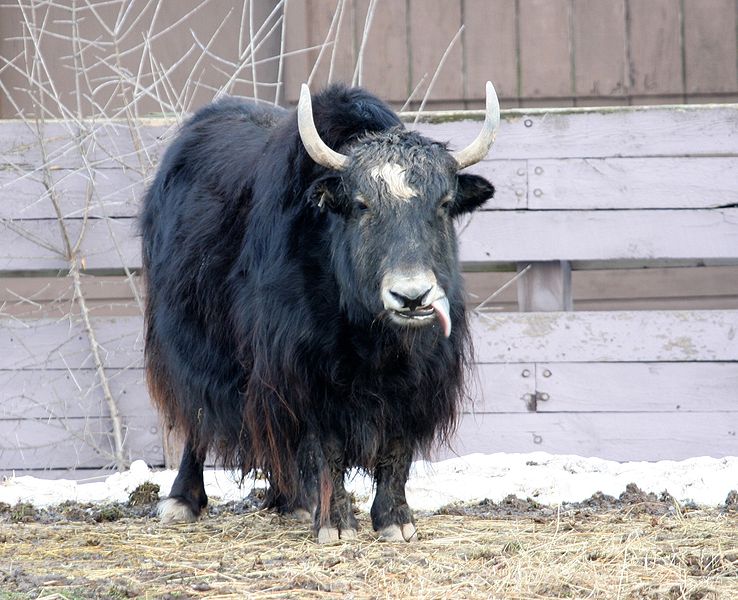
“The yak, Bos grunniens, is a long-haired bovine found throughout the Himalayan region of south Central Asia, the Tibetan Plateau and as far north as Mongolia and Russia. In addition to a large domestic population, there is a small, vulnerable wild yak population.” Wiki
“Body Length: Up to 325 cm / 10.8 ft.
Shoulder Height: Up to 200 cm / 6.6 ft.
Tail Length: 60 cm / 24 in.
Weight: 305-820 kg / 670-1805 lb.
The dark black-brown coat is dense, wooly, and extremely shaggy, although the colour is variable in domestic yaks. ‘Golden’ wild yaks are also known, but are extremely rare. The shoulders are high and humped, with a broad, drooping head. The short legs have broad hooves and large dewclaws as an adaptation to mountainous environments. The horns are found in both sexes, though those of the females are considerably smaller and shorter. They grow up to 51 cm / 20 inches long in females, and 95 cm / 38 inches in males. The curved horns grow out from the sides of the head and curve upwards.”
(Source:http://www.ultimateungulate.com/artiodactyla/bos_grunniens.html)
—————————–
——————————
So its a suprise Kavari maan is not a deer. Then why is it named Kavari Maan. Let see the etymology of Kavari Maan –> Kavari + Maan
Lets fisrt see the root word Kavari in Dravidian Etymology Dicitonary
1327 Ta. kavari chowrie. Ma. kavaram hair-plait; kavari id.; woman with fine hair; yak; yak’s tail, chowrie. Ka. kabari, kavari braid of hair, knot of braided hair. Tu. kabari tufted hair of females. / Cf. Skt. kavara-, kabara-, kavarī-, kabarī braid of hair. DED 1115.
மான்¹ māṉn
, n. < மா². [T. K. M. Tu. mān.] 1. Deer, hart, antelope, fawn; ஒருவகை விலங்கு. மானி னுரிவை தைஇய வூன்கெடு மார்பின் (திருமுரு. 128). 2. Animal, beast; விலங்கின் பொது. (பிங்.) 3. Horse; குதிரை. தெம்முனையுண் மானொடு தோன்றி (பு. வெ. 10, பொது. 5). 4. Lion; சிங்கம். விலங்கு மான்குரல் கேட்பின் வெருவுவை (கலித். 13). 5. Makara fish; மகரமீன். (பிங்.) 6. Capricorn of the zodiac; மகரவிராசி. (பிங்.)
Maan can mean various other animals other than a deer. So Kavari Maan here means a hairy animal.
—————–
—
Other Names used for Yak in Tamil
கானக்குதிரை kāṉa-k-kutirai
, n. < id. +. 1. Yak, Bos grunniens; காட்டுமான்வகை. (பிங்.) 2. Wild horse; காட்டுக்குதிரை. (W.)
எகின் ekiṉn
2. Yak; கவரிமா. (சூடா.)
3. Yak. See கவரிமா. (W.)
, n. < சவரி¹ +. Yak. See கவரிமான்.
—
—————–
Now lets come to second part of the myth — Kavari Maan would die even it loses one hair.
Thirukkural
| மயிர்நீப்பின் வாழாக் கவரிமா அன்னார் உயிர்நீப்பர் மானம் வரின். |
969 |
Translated by G U Pope.
மானக்கவரி māṉan-k-kavari
, n. < மானம்¹ +. 1. Yak, Bos grunniens, as too sensitive to survive the loss of a single hair; கவரிமான். 2. Ornamental whisk, made of yak’s tail; சாமரை. மானக்கவரி மணிவண் டகற்ற (சீவக. 2120).
மானமா māṉan-mā
, n. < id. + மா². Yak, as extremely sensitive. See கவரிமான். மானமா வனைய மாட்சியர் (கம்பரா. உருக்காட். 19).
This myth is taken too seriously and Kavari Maan has been equated to epitome of sensitivity, we have seen people calling them selves ‘Kavarai Maan Parambarai’.
But I looked through various sources and there is no mention of death due to hair loss!!! Only thing I came to know about is that In case of diseases whcih lead to death in Yaks , we see hair loss as symptoms.
The fact that Yak hair was very commonly used in various forms gives us suspicion that this myth has no basis at all.
Yak primarily lives in Himalayas the Indo-Aryan word for it – Camara/Camari is a non aryan derivative ..highly likely from Tamil word Kaviri. Kaviri -> Caamari (Pali) -> Caamar (Sanskirt) .Kaviri –> Cauri (Sanskrit) is back in Tamil as false hair and Caamar’s derivative Camaram (as vensamaram ) is back in Tamil. People forget real usage of kaviri (as false hair, fan made of hair, hairy animal) and its context got completely twisted because of misreading of one thirukkural!

Please see the words below,
, n. < camarī. 1. Yak; கவரி மான். (உரி. நி.) 2. Chowry. See சாமரம். (பிங்.) 3. False hair used by women in toilette; கூந்தலுடன் பின்னுதற்குரிய கவரிமான் மயிர்க்கற்றை. 4. Coir; தென்னைநார்.
சாமரம்² cāmaram
, n. < cāmara. Chowry, bushy tail of the yak, used as a fly-flapper for idols or as a royal insignia; கவரிமானின் மயிரால் அமைந்த இராசசின்னம். (சூடா.)
Yak hair has had two uses –
கவரிமான்மயிர் kavari-māṉ-mayir
1. Chowrie or bushy tail of the camarī, the Tibetan yak (Bos grunniens) set in a decorated handle, used as a fly-flap or fan before an idol or a great personage; சாமரம்.

2. The bushy tail of the yak used as false hair; கூந்த லுடன் இணைத்துப்பின்னுஞ் சவரி. (J.)
,White hair of the yak, used as a fly-whisk and reckoned as one of the insignia of royalty; இராசசின்னமாகக் கொள்ளப்படும் கவரிமானின் மயிர்க்கற்றை. (பதார்த்த. 1475.)
Vensamram (as shown in the video ) is made out white hair of yak. Some Yaks are white as shown below.
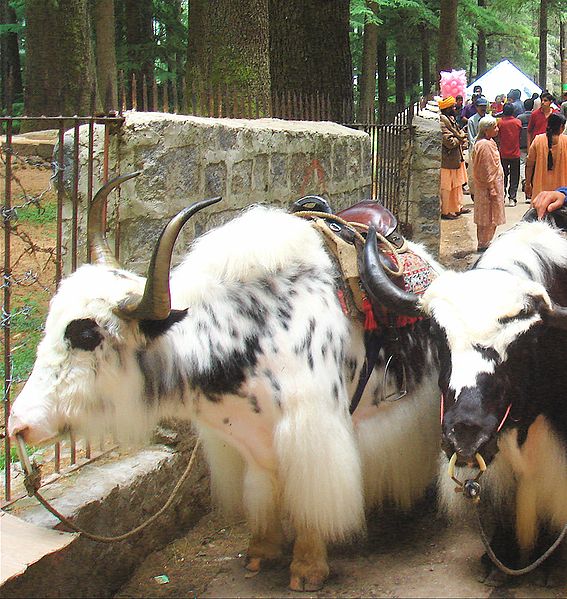
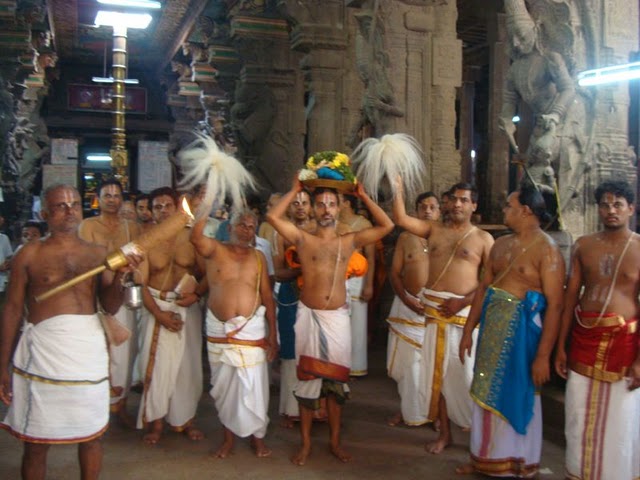
————————-
———–
Other words used for Yak hair
சமரம்³ camaram
, n. < camara. 1. Yak; கவரிமா. 2. A kind of fly-flapper, chowry; சாமரை.
குஞ்சம்³ kuñcam
, n. < kūrca. 1. Chowry, bushy tail of the yak, often set in a richly decorated handle for use as a fly-flapper, as an insignia of royalty; ஈயோட்டி. (சூடா.) 2. Weaver’s brush; பாவாற்றி. (W.)
கோலிக்கற்றை kōli-k-kaṟṟai
, n. < கோலி¹ +. Chowry, tail of the yak; சாமரம். (சங். அக.)
, n. < இடு- +. False hair, usually obtained from the tail of the yak; சவரி. Loc.
ஆகு² āku
, n. 1. cf. Tib. gyāk. The tail of the yak, used as a fan for idols; கவரி. (பிங்.) 2. Navel; கொப்பூழ். (அக. நி.)
———-
Yak hair is still popular false hair. Check this out in google shopping!
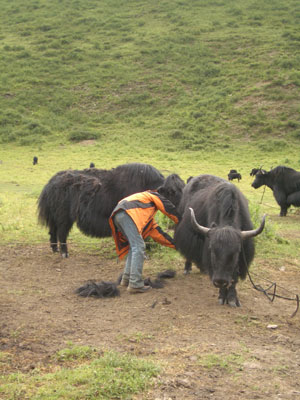
———————–
I hope some myths were broken in this blog. I hope none you utters ‘Kavari Maan Parambarai’ again!
—-
I never knew I have had a raid over the top of a Kavari Maan!
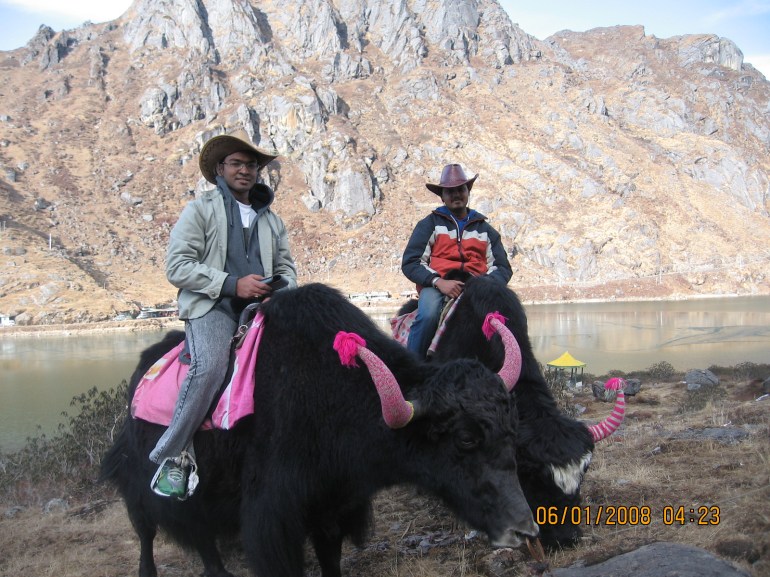
Reference:
Tamil Lexicon-University of Madras
Dravdian Etymology Dictionary
http://en.wikipedia.org/wiki/Yak
http://www.ultimateungulate.com/artiodactyla/bos_grunniens.html
http://www.mammalogy.org/pubjom/…/Leslie_and_Schaller_2009.pdf
——
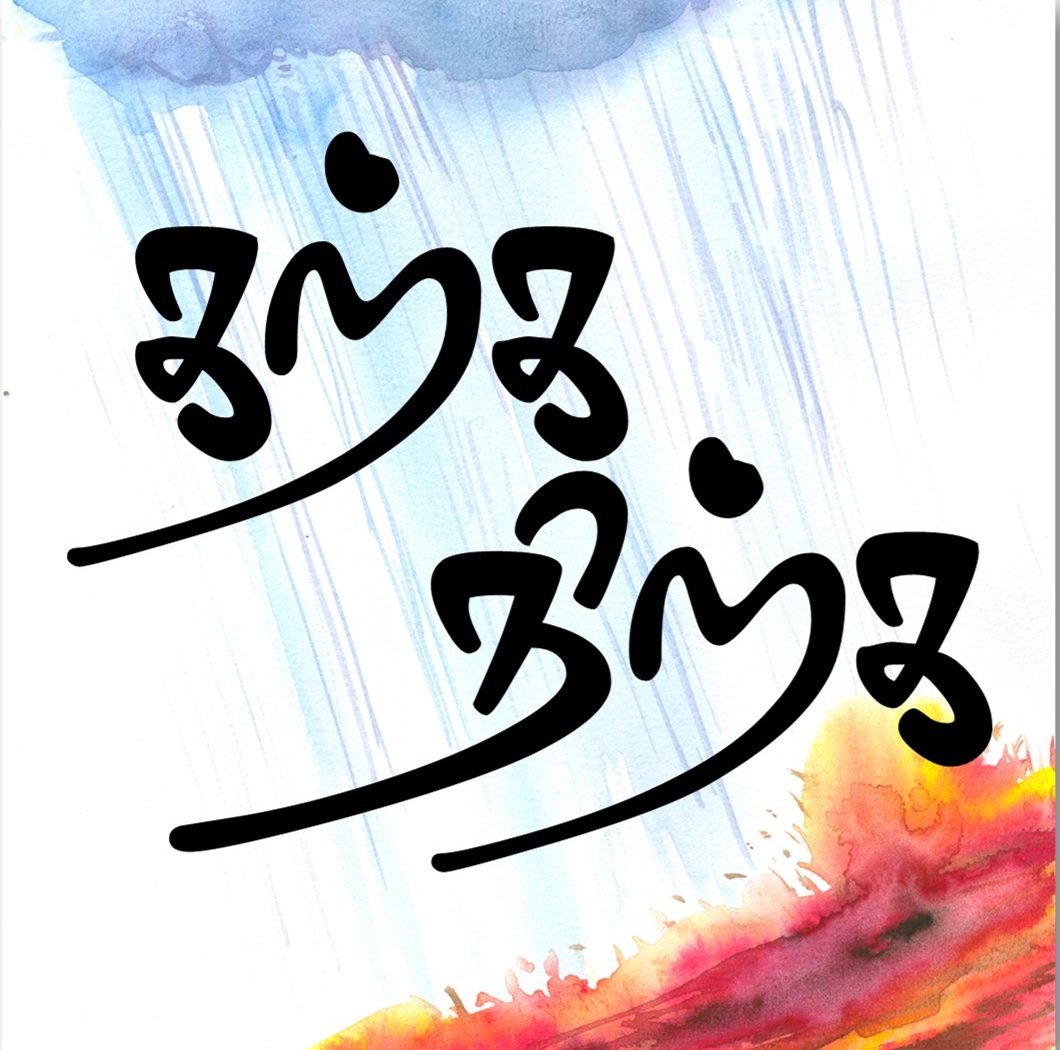

Good research – so all this while we have been using this simile ignorantly!
Hi vairam
Eye opener – but where and when does the use of Kaveri maan as the epitome of virtue come first in our literature?
vj
There another myth busted. Awesome blog.
Yes that is correct. It was Sanskrit “camara” yak-tail , and Genghiz Khan had 9 yak-tails as his flag, as the “Universal Emperor”. In Thailand it is Pali Skt. “chamarra”, royal tassle on the king’s boat, and made from “chamarri” yak.
The European form is seen in “gamsbart” a tassel worn on a hat of Bavaria (Alpine Germany), made from the chamois mountain-deer (gamse/ gemse). The hair is plucked from a freshly killed deer, which suggests that the hair may represent the lost life of the animal. That indicates that royal yak-tails were taken from a remonially killed yak, to take the power of the bull yak to a king. When yaks run fast they raise their tail , as thick as 6 tails of a horse, perhaps resembling a battle flag. The tassel hangs from the mouth of Chinese metal dragons, and is a royal symbol across Europe. In Britain it is worn with chamarre / chimere robes, from “chimairos” a goat-horned lion , Skt. hima (Himalaya), meaning a “winter coat of goat-hair”. It is the yale of Britain, a royal symbolic beast.
The yali horned-lion of India is the same beast, perhaps because the yak looked like a lion with horns.
Dear vairam, u r research is good.But i think the kural in another way.Nature makes rules for its products.It gives thick hair to kavariman to bear the cold of the himalyas.If ther is a loos in hair it will not live.Without hair there is no life for kavariman.Like that whenever thereis a harm to the prestige for a man who thinks prestige more higher than all he will not live.Ex.seran irumporai.Moreover MAIER does not mean single hair.Ther is no singular or plural for maier.So take the word maier neepin vazha
as total nilness of the hair.Pl read kural as it is.Go by nature. Thank u for u r efforts.
Sir,
that is the common misconception. The hair is cut only during particular season. Thats why i posted a photo of yak while its hair is being cut. I have studied every possible source on Yak. They are domesticated and their hair is product for export for centuries. Silapthikaram has atleast 15 references of Yak’s hair being used as Samaram.
So if you come out of the fix that what ever Thiruvalluvar has written has to be true, it can be easily understood. the whole confussion is we assume what ever thiruvalluvar has written has to be true.
Vairam
Pictures of Yak hair being cut…
http://news.cultural-china.com/20090611104705_1.html
Meaning of the couplet could well be changed over a period of time. You do not the have commentary of “Thirukkural” written by Thiruvalluvar himself. I believe it is wrong to come to a conclusion that some couplet said by Thiruvalluvar is wrong or whatever said by Thiruvalluvar is wrong.
I am not concluding anything here. All I am saying is Thiruvalluvar could have reffered to some imaginary animal or some other animal which could have got mixed up with kavari maan. kavari maan as we know in literature is yak and yaks hair was used by Tamilians as Samaram as ealry as 2000 years ago. So either valluvar got his facts wrong or he meant some other animal… I giving both options and not concluding anything..
Yes Vairam. I agree with you.
Another thought provoking post. Excellent.
திரு வைரம் அவர்களுக்கு நன்றி. ஆனால் வள்ளுவன் தவறிழைக்கவும் இல்லை. வேறொரு விலங்கையும் குறிப்பிடவில்லை.
மயிர்நீப்பின் உயிர்வாழா கவரிமா அன்னார்
உயிர்நீப்பர் மானம் வரின். என்பது தான் குறள்.
நீங்கள் சுட்டிக் காட்டும் yak என்ற “கவரிமா” வை தான் சுட்டுகிறார். கவரிமான் என்று அவர் குறிப்பிடவில்லை. பழைய திருக்குறள் பதிப்பை பார்க்கவும். அதாவது குளிரிலிருந்து பாதுகாக்க உதவும் மயிரை கவரிமா இழந்தால் எப்படி அவற்றால் வாழமுடியாதோ, அதைப்போன்று உயர்ந்தோர் அவர்களின் மானத்துக்கு பங்கம் வ்ருமானால் உயிரிழப்பர் என்கிறார்..இங்கு மயிர் என்பதை “ஜாத்யேகவசனம்” ஆக எடுத்துக் கொள்ள வேண்டும். அதாவது ஒரு கூட்டத்தைக் குறிக்கும் போது பன்மையை ஒருமையாக குறிக்கலாம்.
செந்தில்
@Senthil – it is completely fad that Kavari cannot live without hair – it is other way round – it is extremely sensitive to heat – it can live upto -40 degrees because of its special adaptations. Yaks are skinned of their hair every year , like sheep. It is like telling sheep will die if you cut of its hair.
Nice research, well presented. As you say it can be used as false hair, in Enthiran movie the white hair of the villian Robot is of Yak hair.
Even if Valluvar has mentioned about the same Kavari maan, nothing wrong in it, he might have used a saying as an example.
திரு வைரம் அவர்களுக்கு,
மயிர் இல்லாமல் ஒரு நாள் அல்லது சில நாள் உயிர் வாழலாம். மயிரில்லாமலேயே உயிர் வாழும் தகுதி பெற்றது என்றால் பரிணாம கொள்கைபடி இந்த குளிர்பிரதேச மிருகங்கள் மயிரை இழந்திருக்கலாமே? காட்டுவாசியாக இருந்த போது இருந்த உரோமம் மனிதனுக்கு இப்போது இல்லை என்பது உதாரணம்.
மனிதனிடத்தில், அறத்தின் சார்பாக வாழ்வதும், மானத்தின் சார்பாக வாழ்வதும் பரிணாமத்தில் ஏற்பட்ட உயர்வே. தான் அறம் தவறிவிட்டோமே என்று விளங்கியவுடன் நெடுஞ்செழிய பாண்டியன் உயிர் நீத்த விஷயமும் இந்த அடிப்படையில் தான்.
ஆக வள்ளுவன் கூற வந்தது, பரிணாமத்தின் பால் குளிர்பிரதேச மிருகங்களுக்கு மயிர் எப்படி முக்கியமாந்தோ, அதைப் போன்று சான்றோருக்கு மானம். உருவகங்களை (Personifications) உருவங்களாக(Personality) ஆக எடுத்து ஆராய்ந்தால் உண்மைகள் தொலையும்.
செந்தில்.
respected sirs
i totally agree with sri senthil
regards
nandhitha
Nice article.
mA, mAn is a general term used for animal. It can be seen in other compounds such as kaimmA ‘elephant’, arimA ‘lion’ where ari seems like a Semitic loan into Tamil, given that the lion is not native to India (and certainly not to the Tamil speaking region).
Mr. Vairam,
How come Thiruvalluar came to know about yak which exists far away from Tamil Nilam. I don’t think he would have travelled so far.
Those olden days the poets are so confined to their living place and usually do not know what is happening even in the neibouring territory.
Rama perumal
Hearsay – there was active trade route..silk route – tibtean products reached us through this route…the yak hair as samram was used by all the kings. There is even dsecription in Silapthikaram that image of yak was carved out in wooden door – so some traders who used Silk route must have seen it first hand and other might have heard it through hear say.
திரு இராம பெருமாள் அவர்களுக்கு,
எப்போதிருந்தோ வடதேச யாத்திரை செல்வது என்பது இருந்ததே? ஆதிசங்கரர் பத்ரி வரை சென்றுள்ளார்; இராமானுசர் காஷ்மீர் வரை சென்றுள்ளார் என்பவை வரலாறு சொல்லும் உண்மைகள். அப்படி திருவள்ளுவ பெருமானாரும் சென்றிருக்கலாமே..! கவரிமாவை கண்டிருக்கலாமே…
மேலும் தாமரைகண்ணான் உலகு (வைகுந்தம்) என்று வள்ளுவர் கூறுவதால் அங்கு போய் தான் பார்த்து எழுதியிருக்க வேண்டும் என்பதில்லை. இலக்கியங்கள் மூலமாகவோ, திரு வைரம் அவர்கள் கூறியது போல உபயோகபடுத்தும் பொருளின் மூலத்தைப் பற்றி அறியும் போதோ தெரிந்து வைத்திருக்கலாம். இதே அளவையில் தான் பிறன்மனைவிழைதல் பற்றியும், கள்ளுண்ணாமையைப் பற்றியும், மற்றும் அறத்திற்கு மாறுபட்ட பிற செயல்களை கூறும் போதும் திருவள்ளுவர் போன்ற மஹான்கள் மனத்தால் உயர்ந்த நிலையில் இருந்து அவற்றை எழுதுகிறார்கள். அந்த செயல்களை, அவற்றின் தன்மைகளை எப்படி அவர்கள் அறிந்தார்கள்?, அவர்கள் அந்த தவறுகளை செய்தவர்களா? என்று வினா எழுப்ப முடியாது..!
செந்தில்
திரு. செந்தில் அவர்களே,
உங்கள் கருத்துக்கு நன்றி.
திருவள்ளுவர் இமயமலைக்குப் போயிருக்கலாம், கவரிமானைக் கண்டிருக்கலாம் என்ற முடிவுக்கு வருவதெல்லாம் அறிவியல் பூர்வனமான ஆராய்ச்சியல்ல.
” எப்பொருள் யார்யார்வாய்க் கேட்பினும் அப்பொருள் மெய்ப்பொருள் காண்பதறிவு” என்று வள்ளுவரே கூறியிருக்கிறார். அதன் அடிப்படையில்தான் திரு. வைரம் அவர்களிடம் அடியேன் மேலும் விளக்கம் கேட்டிருந்தேன். அவரை சோதிப்பதற்காக அல்ல.
இதுநாள்வரை நாம் அனைவரும் கவரிமான் நமக்குத் தெரிந்த மானினம் சார்ந்த ஒரு விலங்கு என்றுதான் நினைத்துக் கொண்டிந்தோம். ஆனால் திரு வைரம் அவர்கள் படம்போட்டு காண்பித்தபின்புதான் அது முற்றிலும் வேறுபட்ட உருவம் என்பது தெரியவருகிறது. ஒரு மயிர் உதிர்ந்தாலும் அது இறந்து விடும் என்றெல்லாம்கூட நம்பிக்கொண்டிருந்தோம். இதெல்லாம் உண்மையை அறிந்து கொள்ளும் ஆய்வு இல்லாத காரணத்தால்தான். இப்பொழுதும் நீங்கள் அவ்வாறுதான் கூறுகின்றீர்கள்.
குளிர் பிரதேசங்களில் வாழும் அனைத்து உயிரிகளும் கவரிமான் உட்பட தங்களுக்கே உரிய பாதுகாப்பு அம்சங்களை இழந்துவிட்டால் இறந்து விடுவது இயல்புதானே. உண்மை இவ்வாறு இருக்க கவரிமானை மட்டும் மானத்திற்கு உவமையாக வள்ளுவர் ஏன் தேர்ந்ததெடுத்தார்?
இராம. பெருமாள்.
திரு இராம பெருமாளுக்கு,
தங்கள் பதிவினை இப்போது தான் பார்த்தேன். தாமத்திற்கு மன்னிக்கவும்.
ஒருவர் ஒரு விலங்கைப்பற்றி தன்னுடைய இலக்கியத்தில் பதிவு செய்கின்றார் என்றாலே அவர் அந்த விலங்கைப் பற்றி அறிந்திருக்கிறார் என்று தான் அர்த்தம். இதை யதார்த்தமான அறிவைக் கொண்டே தெளியலாம். எந்த தனிப்பட்ட அறிவியல் ஆராய்ச்சியும் தேவையில்லை. திருவள்ளுவர் கூறிய விலங்கை பிற்காலத்தில் வந்தவர்கள் தவறாக மானாக புரிந்து கொண்டு சினிமா படம்(கவரிமான் என்ற படம் சில வருடங்களுக்கு முன்னர் வந்தது) வரை எடுத்தால் அதற்கு திருவள்ளுவர் என்ன செய்வார்?
இயற்கைவாதிகளான நம் முன்னோர்கள் தாம் கண்ட/ மக்களுக்கு புரிகின்ற உதாரணங்கள் மூலம் தான் விளக்கினார்கள். ஒரு பழந்தமிழ் பாட்டு ஒன்று “தாமரையின் அருமையை அருகிலிருக்கும் தவளை அறிந்து கொள்ளாது; எங்கோ காட்டிலிருக்கும் வண்டு தெரிந்து கொண்டு தேடி வ்ரும் என்று கூறி அதைப் போல புல்லர்கள், நல்லோரை அருகிலிருந்தாலும் அறியமாட்டார்கள், அவ்ர் அருமை அறிந்த கற்றறிந்த நல்லோர்கள் எங்கே இருந்தாலும் வந்து சேருவர் என்கிறது. இங்கு நாம் எவ்வளவோ மலர்கள் இருக்க தாமரையை ஏன் எடுத்துக் கொண்டார்கள் என்று கேட்கக் கூடாது..!! சொல்ல வந்த கருத்தை புரிய வைப்பதற்காக ஒரு உதாரணத்தை புலவர் கூறுகிறார் என்று எடுத்துக் கொள்ள வேண்டும். இதைப் போல மானத்தின் தன்மையை எடுத்து கூறுங்கால் வள்ளுவனும் கவ்ரிமாவை எடுத்தாண்டிருக்கிறான்.
செந்தில்.
Dear Mr. Vairam, u r research is good. உளம் கனிந்த பாராடுதல்கள்.
திரு செந்தில் கூறுவது போல் கவரிமா தான் மூலத்திலும், பழம் உரைகளிலும் காணப்படுகிறது. பரிமேலழகர் உரையில்—உரையிலும், குறளிலும்–மா என்றுதான் குறிப்பிடப்பட்டுள்ளது.
மா என்றால் பொருள் தெரியா அண்மைக்காலத்தவர் ‘ன்’ சேர்த்துள்ளார்கள்.
அவ்வளவு தான். திருவள்ளுவர் “கவரிமா அன்னார்” என்று தான் எழுதியுள்ளார். “மான்” இல்லை என்பது கவனிக்கத்தக்கது.
மா = விலங்கு. உதாரணம் அரிமா = சிங்கம், கரிமா = யானை (திருமதி Lakshmi Srinivas அவர்களின் விளக்கம் கவனிக்கத்தக்கது).
கவரிமா = அடர்ந்த முடியுடைய திபெத்திய யாக் என்னும் வனவிலங்கு
கவரிமா = யாக் என்பது மிகவும் சரி.
மயிர் போனால் நடுங்கும் குளிரில் உயிர் துறக்கும். முடி இழந்த விலங்கு எப்படி குளிரில் நடுங்கி இறக்கிறதோ அப்படி மேன்மை பொருந்தியவர்கள் தம் குடும்பப் பெருமை அழிய நேர்ந்தால் உயிர் வாழமாட்டார்.
மேலும் முடியிழந்தால் குளிரில் உயிர்போகும் என்பது தான் பொருள். ஒரு முடி போனால் என்று எங்கும் கூறவில்லை. முடிதிருத்கம் என்றால் ஒரு முடி மட்டும் வெட்டபடும் இடம் என்று அர்த்தம் கொள்ளுதல் அறிவீனம். திரு. vai. Balasubramaniam அவர்களின் கருத்து ஏற்புடையாதாக இருக்கிறது.
பிற்காலத்து உரைகளில் நம்மை போல் உள்ளவர்களால் மான் என்று தவறாக கூறிக்கொண்டிருக்கிறோம்.
“I am not concluding anything here” என்று நீங்கள் கூறியது போல் ஆராய்ச்சி நிலையில் நின்று சிந்தித்தால், ஒன்று தெளிவாக விளங்கும். நீங்கள் தொடங்கிய இந்த ஆராய்ச்சியினால் பல்வேறு அறிஞர்களின் பதில்களினால் சரியான வழிகாட்டுதல் இங்கு கிடைத்திருக்கிறது. அவர்கள் அனைவருக்கும் மனமார்ந்த நன்றி. இனி இந்த தவறுக்கு முற்றுப்புள்ளி வைப்போம்.
திரு. Rama. Perumal உங்களது முதல் கேள்விக்கு:
தமிழ் நாட்டில் சிங்கம் கூடத்தான் இல்லை. அதற்காக
சிங்கம் பற்றிப் பேசாமல் இல்லையே. தமிழ்நாட்டில் மாத்திரம் அல்ல, இலங்கையிலும் சிங்கம் இல்லை. ஆயினும் சீகளம் = சிங்களம் ஆகி, சிங்கம் என்ற சின்னத்தை கொண்டுள்ளனர்.
உங்களின் இரண்டாவது விளக்கத்திற்கு:
தவறாகப்புரிந்து கொண்டிருந்தோம் தெரிந்ததும் அதற்காக வருத்தப்பட்டு திருத்திக்கொள்ளவேண்டும். அது தான் இந்த ஆராய்சியின் உண்மை பலன்.
கவரிமாவின் முடி மற்ற சிறு மிருகங்களின் முடியைக்காட்டிலும் மிகவும் பிரசித்தம். உலக மக்களால் எளிதில் புரிந்துக்கொள்ளமுடியும். இரண்டு அடி குறளில் அனைத்து குளிர்ப்பிரதேச உயிர்களையும் சேர்க்க இடமின்மையும் ஒரு காரணம். திரு இராம பெருமாள், திரு செந்திலின் கருத்தைதான் கூறுகிறார். ஆனால் எதிர்மறையாக. இருவருக்கும் மனமார்ந்த பாராட்டுதல்கள்.
திரு வைரம் உங்கள் ஆராய்ச்சிக்கு மற்றுமொரு தகவல்
கலைஞர் கருணாநிதி அவர்கள் “ஐயன் திருவள்ளுவர்” என்பது இலக்கணப்பிழை, “ஐயர் திருவள்ளுவர்” என்று அவர் எழுதவேண்டும் என்று தைரியமாகக் குறிப்பிட்ட இரா. திருமுருகன் என்பவர். ஐயர் என்பது ஒரு குறிப்பிட்ட இனத்தை குறிப்பது இல்லை. ஐயா என்றால் sir ஐயர் என்றால் respected sir என்றும் பொருள் கொள்ளவேண்டும். உங்களது புதிய கோணம் இருந்தால், கூறவும். நன்றி.
A. Munuswami.
திரு முனுசாமி அவர்களுக்கு,
ஐயன் என்பது இலக்கண பிழையல்ல. ஐயன் என்பது முன்னோன் மற்றும் தலைவன் என்ற பொருள்கள் தரக்கூடியது. ஐயனுக்கும், ஐயருக்கும் உள்ள வித்தியாசம் தலைவன், த்லைவர் என்பதற்கு உள்ள வித்தியாசம் தான். ஐயா என்பது விளிச்சொல்..தலைவா என்பது போல.
செந்தில்
வைரம் அவர்களே,
உங்கள் சங்க இலக்கிய ஆய்வுகளுக்கு எனது மனமார்ந்த நன்றிகள். ஆய்அண்டிரன் குறித்த சங்ககாலபாடலொன்று,
” நரந்தை நறும்புன் மேய்ந்த கவரி
குவளைப் பைஞ்சுனை பருகி அயல
தகரத் தண்நிழல் பிணையொடு வதியும்
வடதிசை அதுவே வான்தோய் இமயம் ” என்கிறது.
(புறநானூற்று பாடல் எண் : 132 )
கவரிமா என்பது வட திசையில் உள்ள இமய மலையில் காணப்படும் விலங்கு என இப்பாடல் தெளிவாகக் குறிப்பிடுகிறது. பதிற்றுப் பத்தின் இரண்டாவது பத்தைப் பாடிய குமட்டூர் கண்ணனார் அவர்களும் இமய மலையில் கவரிமா உள்ளதாகக் குறிப்பிடுகிறார். ஆக சங்க இலக்கிய புலவர்கள் கவரிமா குறித்து தெளிவாக அறிந்துள்ளனர் என்பது உறுதி. இராம பெருமாள் அவர்கள், திருவள்ளுவர் காலத்தில் பக்கத்து நாடுகள் குறித்து கூட தமிழ்ப் புலவர்கள் அறிந்திருக்க வாய்ப்பில்லை என்று குறிபிட்டுள்ளார். இதை ஏற்றுக்கொள்ள முடியாது. மாமூலனார் என்ற சங்கப் புலவர் தனது பாலைப் பாடல்களில் தமிழகத்துக்கு அப்பாற்பட்ட மொழிபெயர் தேயங்கள் குறித்து பல பாடல்களை பாடியுள்ளார். மகத நந்தர்கள், மௌரியர்கள் குறித்த பாடல்கள் சங்க இலக்கியத்தில் உள்ளன. தமிழர்கள் சங்க காலத்தில் கிரேக்கம், ரோம், எகிப்து போன்ற மேற்குலக நாடுகளோடும் தாய்லாந்து, மலேசியா, சீனா போன்ற கிழக்குலக நாடுகளோடும் வணிகத் தொடர்புகள் கொண்டிருந்தனர் என்பதற்கு நிறைய சான்றுகள் கிடைத்துள்ளன. எகிப்திலும், தாய்லாந்திலும், சங்ககாலத் தமிழி எழுத்துக்கள் கூட கிடைத்துள்ளன. (1.Wednesday, Nov 21, 2007-Tamil Brahmi script in Egypt ; 2.Sunday, Jul 16, 2006 -Tamil-Brahmi inscription on pottery found in Thailand ; 3.June 24, 2010-An epigraphic perspective on the antiquity of Tamil ) .
மராட்டியம் முதல் தக்காணத்தின் பெரும்பகுதியை ஆண்ட சாதவாகனர்கள் (கி.மு.230 முதல் கி.பி.2 ஆம் நூற்றாண்டு வரை ) தங்கள் நாணயங்களில் தமிழ், பிராகிரதம் மொழிகளை பயன்படுத்தியுள்ளனர்.
எனவே தமிழர்கள் சங்ககாலத்தில் இந்தியத் துணைக் கண்டம் , மேற்குலக, கிழக்குலக நாடுகள் அனைத்துடனும் வணிகத் தொடர்பு கொண்டுருந்தனர் என்பதும், அவைகளைப் பற்றி நன்கு அறிந்திருந்தனர் என்பதும் தெளிவாகிறது.
கணியன் பாலன்.
வைரம் அவர்களே,
சங்ககாலப் பாடல்களில் பெரும்பாலானவை மதச்சார்பற்றவை, அறிவியல் கண்ணோட்டமும் பொருள்முதல்வாத தன்மையும் கொண்டவை. இராம பெருமாள் அவர்களின் கருத்து பிற்காலத் தமிழ் உரை ஆசிரியர்களுக்கும், புலவர்களுக்கும் ஓரளவு பொருந்தும். ஆனால் சங்க காலப் புலவர்களுக்குப் பொருந்தாது. சங்க இலக்கியங்களை அதன் பன்முக நோக்கில் அறிமுகப்படுத்தும் உங்களது தமிழ்ப் பணி தொடரட்டும்.
கணியன் பாலன்.
Congratulations to Vairam for initiating such a wonderful thought provoking discussion. I admire all of you and fully agree with Vai.Ba, Senthil and Balan. I learnt a lot today.
Yogi Suddhananda Bharati has translated kavarimaa as Yak.
“Honour lost, the noble expire
like a Yak that loses its hair”
Poetry is always superlative. The example need not exactly match the message to be conveyed. Example is given to create an impact. Hence Saint Thiruvalluvar has used this example which is in fact a fact.
Hair is a vestigeal organ for human beings since it serves no useful or vital function. But hair is a very important vital organ for animals especially during winter for the ones who live in high altitudes. Hair is essential for maintaining optimum thermostasis at sub zero temperatures, so that the internal organs are protected. Hair in animals is a very important protective organ. Hair is mandatory for survival atleast during winter for yaks
Hence it is meant that honour is essential for a noble like the hair for a yak.
warm regards
Dr S Murugusundram
Founder secretary
The hair research society of India
டாக்டர் முருகுசுந்தரம் அவர்களுக்கு,
தங்கள் கருத்துக்கு நன்றி.
ஆனால் எவ்வாறு மனிதனுக்கு உரோமம் பயனற்றது (vestigeal organ)என்கிறீர்கள். அது ஏன் என்பது புரியவில்லை. தலையில் பிறப்பிலிருந்தும், மற்ற உடல்பாகங்களில் சில வயதுக்குப் பிறகும் முளைக்கும் உரோமம் பயன் மற்றும் காரணமின்றியா? சிலருக்கு உடலில் அதிகமாக உரோமம் இருப்பதும்(ஒரே ஊரிலிருப்பவர்களின் மத்தியிலேயே) சிலருக்கு உரோமம் குறைவாக இருப்பதற்கும் காரணமே இல்லையா? மேலும் உரோமம் சிலிர்ப்பது எதனால் என்பதைப் பற்றிய விவரங்களை விளக்குமாறு தாழ்மையுடன் கேட்டுக் கொள்கிறேன்.
செந்தில்
Dear Senthil
Hair is vestigeal in humans because loss of hair will not lead to loss of life. But in the present scenario hair in humans is also considered an essential organ because of its pluripotent stem cells which can form any tissue when expended in culture.
As man (homosapien) evolved from animal hair is lost from the body but the scalp hair is retained, probably to protect from sun since only the scalp is exposed maximally in the erectile posture. Now the scalp hair is also receding in majority and baldness is becoming increasingly common. Probably a new superspecies (totally hairless) is evolving from man!
The body hair especially the facial, axillary and the pubic hair is called the secondary sexual hair which grows after puberty under the influenze of androgens. There is a variation in this within the same locality as you mentioned because of the genetic masaicism. Since we Indians have mixture of Afro-Euro-Asian genes the distribution of body hair can be minimum to maximum. For example the beard of a normal potent young man can be very minimal like the Japanese to the maximum thick dense beard like a caucasian or an african.
The hair raising question of gooseflesh is due to a small uscle which is attached to the hair. it is called as arrectores pilorum (which means the muscle for hair erection). Most importantly this muscle gains importance because the hair follicle stem cells (bulge cells) are located at the insertion of this muscle to the hair follicle.
Hope I have cleared your querries senthil.
warmly
murugu
Thanks Vairam.
A very good and detailed analysis. It helped to clear lot of myths about Kavari Maan. And my thanks to Senthil for bringing in a new perspective to the analysis. A very good discussion.
டாக்டர் முருகுசுந்தரம் அவர்களுக்கு,
உரோமம் தேவையற்றது(vestigious) என்ற விஞ்ஞான கருத்து தற்போது மாறிக் கொண்டிருக்கிறது என்பதைப் பற்றிய தங்களின் விரிவான விளக்கத்துக்கு நன்றி.
மேலும் ஒரு சந்தேகம். வழுக்கை விழுபவர்களுக்கு கூட பின் மண்டையில் அதன் பாதிப்பு இல்லாமல் பிறை சந்திரன் போல் உரோமங்கள் இருக்கிறதே..! எதற்காக? முழு வழுக்கையாளர்களைப் பார்ப்பது மிக அரிதாகத் தானே இருக்கிறது. இதற்கு விஞ்ஞான ரீதியான விளக்கம் இருக்கிறதா?
உடல் உரோமம் சிலிர்ப்பதன் காரணம் அதற்கு கீழே உள்ள தசை (arrectores pilorum) என்று கூறியுள்ளீர்கள். உரோமத்தில் நரம்புகளோ, தசைகளோ இல்லை. இரத்தமும் பாய்வதில்லை. அப்படியிருக்க கீழே இந்த arrectores pilorum என்ற தசை இருந்தாலும் உரோமத்தால் எப்படி குத்திட்டு நிற்க முடிகிறது? அதுவும் சில சமயங்களில் மட்டும் தான். இந்த நிலையை எது நிர்ணயிக்கிறது?
செந்தில்.
I am a member of a glossary panel based in Toronto. We are working on English to Tamil terminology (http://kalaichotkovai.blogspot.com/). While looking for a Tamil equivalent of YAK included in our proposed list of animal names I hit upon your exchange of messages over கவரிமா(ன்).
Almost all our Tamil-English and English-Tamil dictionaries match கவரிமா(ன்) with YAK, perhaps, based on the fact that G. U. Pope and Winslow considered them equivalents. No doubt YAK is just a hairy Tibetan ox, not a deer. Maybe Pope and Winslow matched கவரிமா(ன்) with YAK mistakenly.
By கவரிமா(ன்) Thiruvalluvar may have simply meant the attractive deer he viewed with envy, not the yak beyond his view, away in Tibet. According to the attached information, a deer may die when hair loss is caused by a serious disease. In other words, a deer’s hair loss foreshadows a risk to its life. Thiruvalluvar, like Plato, was not just a philosopher but a poet. He enjoyed his poetic license to interpret the so-called deer hair loss syndrome as honour suicide. Such figures of speech include personification and pathetic fallacy.
Mani Velupillai
Here is the link for the relevant information:
http://www.ehow.com/about_6639922_would-deer-losing-its-hair_.html
“Why Would a Deer Be Losing Its Hair?”
“A deer can lose its hair due to disease, parasites or through a natural process. Sometimes the hair grows back and the deer is no longer affected, but it may die when hair loss is caused by a serious disease…”
திரு மணி வேலுபிள்ளை அவர்களுக்கு,
மானத்தைப் பற்றி சொல்லும் போது வியாதியில் இறப்பதை உபமானமாக கொள்வது ஹீனோபமானமாகும். அதாவது இலக்கிய பார்வையில் அது ஒரு தாழ்ந்த உபமானமாக கொள்ளப்படும். கவரிமாவை எப்படி உரோமம் காக்கிறதோ, அதைப் போல உயர்ந்தோரை மானம் காக்கிறது. உரோமம்/மானம் அழிபட்டால் கவரிமா/உயர்ந்தோர் அழிவர் என்பது தான் நற்பொருளாக நம் முன்னோர் உரையிலிருந்து தெளிகிறோம்.
மேலும் திருவள்ளுவருக்கு கவரிமாவைப்(yak) பற்றி தெரிந்திருக்க முடியாது என்கின்ற தங்களுடைய கருத்தும் ஏற்புடையதல்ல. மேலேயுள்ள அனைத்து பதிவுகளையும் படிக்குமாறு கேட்டுக் கொள்கிறேன். தமிழ் இலக்கியத்ததில் “கவரி” பற்றிய பதிவுகள், அரசர்களுக்கும், கடவுளின் சிலா உருவங்களுக்கும் கவரி வீசுதல் என்கின்ற பழக்கம் இருந்தது என்பவைப் பற்றியும் முன்னமே பதிந்திருக்கிறார்கள்.
செந்தில்.
குரிக்எடுத்துக்காட்டுகள் கொடுக்கப்பட்டுள்ளன.
கவரிமா(ன்) குறித்து விளக்கம் தந்த திரு. செந்தில் அவர்களுக்கு மிக்க நன்றி. உங்கள் குறிப்பை பெரிதும் ஏற்றுக்கொள்கிறேன்.
நீங்கள் YAK, கவரிமா இரண்டையும் நேரொத்த சொற்களாகத் தீர்வுசெய்து எனது குறிப்புக்குப் பொருள் கொண்டிருக்கிறீர்கள். ஆதலால்தான் “திருவள்ளுவருக்கு கவரிமாவைப் (yak) பற்றி தெரிந்திருக்க முடியாது என்கின்ற தங்களுடைய கருத்தும் ஏற்புடையதல்ல” என்று நீங்கள் எழுத நேர்ந்துள்ளது.
“தமது கண்ணுக்கு எட்டாத திபெத்திய சடை எருதை விடுத்து, தமது கண்ணுக்கு எட்டிய கவர்ச்சி மானை அவர் கருதியிருக்கலாம்” என்று பொருள்படும் வண்ணம் எழுதியிருக்கிறேன் [By கவரிமா(ன்) Thiruvalluvar may have simply meant the attractive deer he viewed with envy, not the yak beyond his view, away in Tibet]. வள்ளுவர் “கருதியிருக்கலாம்” என்று குறிப்பிட்டேன். “கருதினார்” என்று குறிப்பிடவில்லை.
நீங்கள் கேட்டுக்கொண்டவாறு அனைத்துப் பதிவுகளையும் நான் மீள்நோக்கினேன். YAK, கவரிமா இரண்டும் நேரொத்த சொற்களா இல்லையா என்பதில் இந்தச் சர்ச்சை தொடங்கியதை மீண்டும் உறுதிப்படுத்திக் கொண்டேன்.
“YAK = a long-haired humped Tibetan ox Bos grunniens (Tibetan: gyag)” [Oxford Dictionary]. இந்த வரையறையின்படி எனது குறிப்பு அமைந்துள்ளது. உறுதிப்படுத்தப்படும் வரை இந்த விலங்கை “சடை எருது” என்று கொள்ளலம் அல்லவா.
திரு மணி வேலுபிள்ளை அவர்களுக்கு,
தங்களின் பதிவுக்கு நன்றி.
மா என்பது விலங்கின் பொதுப் பெயர். கவரி என்பது அடர்ந்த உரோமம். ஆக அடர்ந்த உரோமத்தோடு கூடிய அனைத்து விலங்குகளையும் yak உட்பட கவரிமா எனலாம். மற்றொரு உதாரணம்: கைம்மா என்றால் யானை. நமக்கு தெரிந்து கையுடன் இருக்கும் விலங்கு யானை தான். மேலும் சில விலங்குகள் கையுடன் கிடைக்கப் பெற்றால் அதற்கும் கைம்மா என்பது பொருந்தும்.
திருவள்ளுவர் மானத்தைப் பற்றிய தன் கருத்தை சொல்லுங்கால் கவரிமாவை சுட்டியுள்ளார். தமிழ்நாட்டில் கவரியுடன் கூடிய மா இருந்ததாக தெரியவில்லை. அப்படியே இருந்திருந்தாலும் கவரியை இழந்தாலும் வாழக்கூடிய தட்பநிலையை கொண்டது தான் தமிழகம். ஆக திருவள்ளுவர் கருத்துக்கு அதாவது “குளிர் காலத்தில் தன்னை வெப்பப்படுத்திக் கொள்ள கொடுக்கப்பட்டிருக்கும் அடர்த்தியான உரோமங்களை இழந்தால் எப்படி அந்த விலங்கு உயிர் வாழாதோ அதைப் போன்று மானம் போனால் உயர்ந்தோர் உயிர் நீப்பர்” என்ற கருத்துக்கு ஒப்பாக இருப்பது வடநாட்டில் இருக்கும் கவரிமா தான் என்பது எமது கருத்து.
செந்தில்.
மேற்கொண்டு குறளுக்கு விளக்கமளித்த திரு. செந்தில் அவர்களின் மிக்க நன்றி. உங்கள் விளக்கம் வியக்கத்தக்கது.
இக்குறளில் வள்ளுவர் உணர்த்தும் பொருள் வெள்ளிடை மலை. அதனைக் குறித்து எவரும் சர்ச்சைப்படுவதாகத் தெரியவில்லை.
எனினும் வள்ளுவர் கூறிய கவரிமா(ன்) வேறு, Oxford கூறும் YAK வேறு. மற்றும்படி உங்கள் கருத்துடன் நான் முற்றிலும் உடன்படுகிறேன்.
மணி வேலுப்பிள்ளை
மேற்கொண்டு குறளுக்கு விளக்கமளித்த திரு. செந்தில் அவர்களுக்கு மிக்க நன்றி. உங்கள் விளக்கம் வியக்கத்தக்கது.
இக்குறளில் வள்ளுவர் உணர்த்தும் பொருள் வெள்ளிடை மலை. அதனைக் குறித்து எவரும் சர்ச்சைப்படுவதாகத் தெரியவில்லை.
எனினும் வள்ளுவர் கூறிய கவரிமா(ன்) வேறு, Oxford கூறும் YAK வேறு. மற்றும்படி உங்கள் கருத்துடன் நான் முற்றிலும் உடன்படுகிறேன்.
மணி வேலுப்பிள்ளை
திரு மணி வேலுபிள்ளை அவர்களுக்கு,
நன்றி. ஆனால் தங்களுடைய கருத்தான “எனினும் வள்ளுவர் கூறிய கவரிமா(ன்) வேறு, Oxford கூறும் YAK வேறு” என்பதை விளக்க முடியுமா?
Oxford dictionary கொடுப்பதை கீழே கொடுத்திருக்கிறேன்.
“a large domesticated wild ox with shaggy hair, humped shoulders , and large horns , used in Tibet as a pack animal and for its milk, meat, and hide”
“Shaggy Hair” என்பது தானே கவரி.
செந்தில்
nalla aaraaichi…. 🙂
Nice research,
Regarding the Kural, Its symbolic representation of death, as its age the the Gaur/Bison looses its hair continuously and it shows its old age and finally going to die.
Also note the word “Gaur/Kaveri” looks similar.
Dear Mr. Mani Velupillai,
regarding Kavar~Yak issue, please read the Puranaanootruppaadal mentioned by Mr. Balan. You may then agree with Mr. Senthil and others.
nanRi
nambi
Hi All,
Very nice start and great discussion. Thanks for one and all. Sorry i am not good at using tamil fonts, Valluvar with so much knoledge in every field of human endover, should be some kind of enlightened one and from my view need not travel to places to know things. Secondly Virams explanation was very good and thought provoking.
Its highly possiable he describes a hairy animal like YAK or some thing that is extinct, both are possiable. Take it in a poietic sence and logical sence makes things good.
Thanks for all this Viram
Dear Mr Vairam kavari is a animal not deer.it will live only cold area (himalaya tibetside also) It have fully hairbody. our sangam literature mention( pathithupathu2:21 &5:3) purananooru132 also.but thirukural also mention is a animal.but parimelahzer wrote maa is deer.but not deer is a animal.
I had reached this weblink upon searching the Kavarimaan referring to “Kavarimaan is a Poimaan ” info,( letter to DInamani) and had got very good information on the same.
Good research by Mr.Vairam and very good arguments from Mr.Senthil. It was very informative. Thanks.
Regards,
Ashok
Nice debate Mr.senthil,vairam,balan & everybody..Learnt a lot today..thanks 🙂
நல்ல தகவல். உங்கள் ஆய்வுக்கு நன்றி.
நல்ல விளக்கம். உங்கள் ஆய்வுக்கு நன்றி.
The only problem with all our research (including about “Thiruvalluvar”) is that it is only Google based. Though your research is very good and shows your interest in our language all that I can say is that there might have definitely been animals which were there during Valluvar’s time and distinct by now. We for sure know that all that Valluvar has said and written is true. When that be the case there must have been an animal (deer/yak) which by then would have become extinct (if it is going to die once its hair is removed) and knowing what great hunters all our forefathers were. So, from your research one thing can be concluded that the “Kavari Mann” in question would have been a distant relative to the yak referred to by you. But, definitely your research (based on the words in Tamil literature) is good and shows that what all of us have been thinking as a deer may be a different animal too.
see… a research is applaudable. clearing a myth is astounding but those who have read and start jumping to conclusion is shallow… However trying to see mistake in the mighty Thirukural is simply idiocracy and unforgivable… shows the shallow depth of your mind and your birth! Just Who the hell are you to even think u have the capacity to be in par with evaluating the Thirukural!
Kural-ai pilaithavanaium tamil-ai pilaithavanaium thaai thaduthum vidaen… mudinthal nallathu sei.. illeiyel un sillarai thanamaana arivai kuppayil podu. tamilai patri ethuvum pesalaam, ketka evenum illai endre nineippa.?? koooru-ketteveneh!
Tamil alla-thavarku vendukol… mudinthal tamilukku uthavi sei, illeiyel.. un veleiyai paarthu nada. unakku irukkum sittrarivai vaithu en ina-thin thirukural-ai purang-koorathe… unakku naan vidukum ech-arikai!!!!
see… a research is applaudable. clearing a myth is astounding but those who have read and start jumping to conclusion is shallow… However trying to see mistake in the mighty Thirukural is simply idiocracy and unforgivable… shows the shallow depth of your mind and your birth! Just Who the hell are you to even think u have the capacity to be in par with evaluating the Thirukural!
Kural-ai pilaithavanaium tamil-ai pilaithavanaium thaai thaduthum vidaen… mudinthal nallathu sei.. illeiyel un sillarai thanamaana arivai kuppayil podu. tamilai patri ethuvum pesalaam, ketka evenum illai endre nineippa.?? koooru-ketteveneh!
Tamil alla-thavarku vendukol… mudinthal tamilukku uthavi sei, illeiyel.. un veleiyai paarthu nada. unakku irukkum sittrarivai vaithu en ina-thin thirukural-ai purang-koorathe… unakku naan vidukum ech-arikai!!!!
நல்ல முயற்சி வைரம், நல்ல பதிவும். பாராட்டுகின்றேன். கவரி என்பது Yak என்பது நெடுங்காலமாக அறிந்த ஒன்று. பி.எல். சாமி அவர்களின் சங்க இலக்கியத்தில் விலங்கின விளக்கம் என்னும் நூலைப் பாருங்கள். திருவள்ளுவரின் குறளுக்கு நீங்கள் கொண்ட பொருள் வேறு பலரும் கொண்டது போல் முற்றிலும் தவறு.
மயிர்நீப்பின் வாழாக் கவரிமா அன்னார்
உயிர்நீப்பர் மானம் வரின்.
என்னும் குறளுக்கு உண்மையான பொருள் என்னவென்றால், எப்படி (குளிர் மிக்க இமயமலைப்பகுதியில் நரந்தம் புல்லை உண்டு வாழும்) கவரிமான் (Yak) மயிரை நீக்கினால் அது குளிர்தாங்காமல் இறாந்துவிடுமோ அதுபோல் மானம் போனால் தாங்காமல் தம்உயிர் நீப்பர் என்பதே பொருள். இது பி.எல். சாமி உரைத்த மெய்ப்பொருள். கவரி என்னும் உண்மையான (கற்பனை அன்று) விலங்கைப் பற்றி சங்க இலக்கியத்துல் பல இடங்களில் கூறப்பட்டுள்ளது. அது குளிர் நிறைந்த இமயமலைப்பகுதியில் வாழ்கின்றது, மணம் பொருந்திய நரந்தை என்னும் புல்லை உண்டு வாழ்கின்றது என்று பல செய்திகள் கொன்டிருக்கின்றன. ஒரு முடி விழுந்தாலும் உயிர்விடும் மான் இனம் (புள்ளிமான் போல் deer இனம்) என்று சொன்னதெல்லாம் அவர்களின் அறியாமையால். தேவநேயப்பாவாணர் வரை பலரும் இப்பிழையைச் செய்திருக்கின்றனர். பல முறை சங்க இலக்கியத்தில் ஆண்ட இச்சொல்லை ஏன் பலரும் பிறழ உணர்ந்தார்கள் என்பது வியப்பே, ஆனால் பி.எல். சாமி அவர்கள் ஐயத்திற்கு இடமின்றி இது இமய மலைவாழ் யாக்கு என்று ஆங்கிலத்தில் கூறப்படும் ஆவினமே என்று காட்டியுள்ளார். இதனை நான் கடந்த 20 ஆண்டுகளாகப் பல இடங்களில் வலியுறுத்தி எழுதியும் வந்திருக்கின்றேன். குறள் கூறியது அருமையான உவமை. அறிவார்ந்த உவமை.
கவரிமா என்பது மானே இல்லை.இதை மான் என்று முதன்முதலில் குறிப்பிட்டவர் திருக்குறளுக்கு உரை எழுதிய பரிமேழலகர்.மா என்பது ஒரு விலங்கு மாடு எனவும் சங்க இலக்கியத்தில் பொருள்.கவரிமா சங்க இலக்கியத்திலும்(பதிற்று பத்து 2:21, 5:3,புறநானூறு :132) மற்றும் திருக்குறளிலும் சரியாகவே குறிக்கப்பட்டுள்ளது.
cool..very deep indeed..my father used to say one thing about this ‘kavari maan’, that, as this lives in mountains, nature has given hair like this to protect from cold weather..so, obviously if it losses its hair, it ll die because of cold weather..
வாழ்கை முழுவதும் நான் தமிழ் தமிழர் சம்பந்தப்பட்ட மூட நம்பிக்கை அடிப்படியோ அல்லது அறிவியல் பூர்வமான ஆதாரமோ இல்லவர்ரைகளை வாதம் செய்து கொண்டு இருந்தேன்…
ஒரு வாரம் முன்பு எனக்கு நடந்த ஒரு அவமானத்தால் (அலுவலகத்தில் எனக்கு கீழ் வேலை செய்யும் ஒரு வெள்ளைகாரி நான் இடும் உத்திரவகுளை ஏற்க்க மறுத்துவிட்டால்..வேலையில் இருந்து வெளியேற்ற பட்டபின் என்னை மிகவும் அவமானபடுத்தி விட்டால் நானும் எனது தேசத்திலிருந்து வரும் நபர்களும் வெள்ளையர்களுக்கு ஆணை இட தகுதி அற்ற வர்கள் என..ஏழு வருடங்கள் பின்பு நான் உணர்கிறேன்)
ஆதலால் கருது வேறுபாடுகள் இருக்கலாம்…
ஆனால் நமது கலாச்சாரத்தையும் மற்ற விஷயங்களையும் சிலுவையில் ஏற்ற வேண்டாம்…
There is no doubt that Tamils had a lifestyle with high moral standards. This effort by you will go a long way in reiterating the specialty of our language Tamil and Tamil speaking population in Asia.
Tamizh vazhga.
Vazhga thamizhinam..
குறள் கூறும் கவரிமான் இன்றில்லை (extinct)